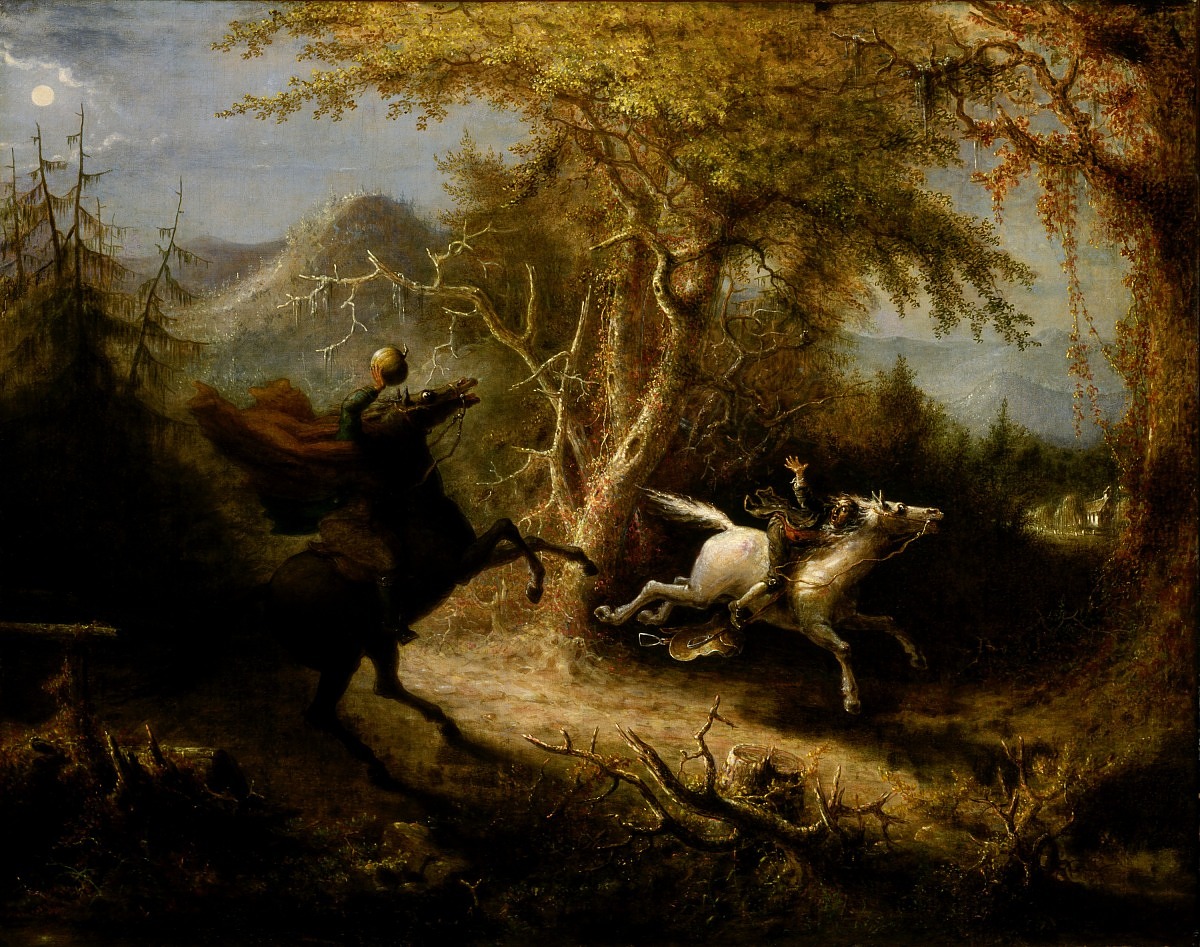
John Quidor (1801–1881)
Public Domain
Smithsonian American Art Museum artwork ID 34285
The dominant spirit, however, that haunts this enchanted region, and seems to be commander-in-chief of the powers of the air, is the apparition of a figure on horseback without a head. It is said by some to be the ghost of a Hessian trooper, whose head had been carried away by a cannonball, in some nameless battle during the Revolutionary War, and who is ever and anon seen by the country folk, hurrying along in the gloom of night, as if on the wings of the wind. (Washington Irving, The Legend of Sleepy Hollow)
The Legend of Sleepy Hollow is a unique American story written by Washington Irving in 1820 and remains popular to this day. The story takes place in a small village in New York called Sleepy Hollow. There in this idyllic location that seems full of enchantment and magic is where the action takes place. And it is here that a wandering teacher arrives to teach the children of the farmers the basics they need to know. Ichabod Crane is a figure of some amusement to the people. He is exceedingly lanky with long arms that came out of sleeves and feet that could be shovels reminding one of a scarecrow, only this one walked. To cap it off he had a small head with large ears with a long nose to boot.
“…tall, but exceedingly lank, with narrow shoulders, long arms and legs, hands that dangled a mile out of his sleeves, feet that might have served for shovels, and his whole frame most loosely hung together. His head was small, and flat at top, with huge ears, large green glassy eyes, and a long snipe nose, so that it looked like a weather-cock perched upon his spindle neck, to tell which way the wind blew.” (The Legend of Sleepy Hallow)
Teaching paid just barely enough for him and as was the custom of the time, he was boarded and lodged with the parents of the children for a week at a time. He wants most desperately to advance and get well situated so he will not starve or be poor again. And he sees in Sleepy Hollow just such a chance in perhaps currying favor with locals and marrying into a family of means. He also considered himself expert on the supernatural having read the important books of his day. He would share is knowledge of it when attending dinners or other events relating interesting anecdotes along the way. And he would hear the story of the Headless Horseman, a Hessian soldier who lost his head in a nameless battle during the Revolution, who rides to and fro at night in search of it and perhaps to collect one from the living.
Crane becomes attracted to Katrina Van Tassel, the daughter of Baltus Van Tassel. He begins courting her in the hopes of marrying her and enjoying the life of a gentleman farmer. He has images in his head of his future life with her and seems confident he will win her heart. Alas there is one wrinkle in the form of Abraham “Bram Bones” Van Brunt, the town rowdy, who wants to marry her. Despite his efforts to humiliate or punish him, Ichabod is undaunted. It is at a harvest festival where things come to a head. He apparently asks her to marry him but alas, it did not go as planned. He leaves the harvest festival “with the air of one who had been sacking a enroots, rather than a fair lady’s heart.” Ouch. It turns out that Katrina was courting him to increase Brom’s desire for her. So, Ichabod leaves feeling quite desolate and not in any hurry to get home.
“Gigantic in height, and muffled in a cloak, Ichabod was horror-struck on perceiving that he was headless! But his horror was still more increased on observing that the head, which should have rested on his shoulders, was carried before him on the pommel of his saddle!” (The Legend of Sleepy Hollow)
It is on his way home that Ichabod encounters the Headless Horseman, who gives him chase as Crane pushes the old stead Gunpowder to move fast. He gets to the bridge where it is said the ghost cannot cross but alas Ichabod does not make it. The Horseman throws his head at him knocking Ichabod off the horse. The horse is found the next day and backtracking they find his hat near the old bridge along with a shattered pumpkin. He is never seen again but many believe he was carried off by the Headless Horseman. However, the account also indicates that Ichabod, frightened by his encounter and not wanting to face his angry landlord (and probably not wanting to see Katrina much again), left that night for parts unknown. It is related he may have become a judge. Meanwhile Katrina marries Brom. And whenever the subject comes up about Ichabod Crane, seems to be “exceedingly knowing” and laughs. Whether he just upped and left or was taken by the Headless Horseman remains a mystery. And makes the tale, now internationally popular, wonderful to read each Autumn and on Halloween.
Screen Adaptations (Selected List)
There is a 1992 silent film called The Headless Horseman and has a young Will Rogers as Ichabod Crane. It was filmed on location in New York’s Hudson Valley. I saw this on Amazon Prime and it was pretty good. It was mostly faithful to the story and well done considering the limitations of the time.
Disney did an adaptation of in its 1949 the Adventures of Ichabod ad Mr. Toad. This light-hearted version has Bing Crosby as the narrator and singing most of the songs. It tones down the story to make it family friendly. The famous chase scene at the end is very well done and longer than the book. And in this adaptation, there really is a ghost Headless Horseman rather than Bram Bones dressed up as the ghost. So, it leaves you in the end with the possibility he was indeed spirited away although rumor may suggest otherwise.
Tim Burton went a very different route in his 1999 movie Sleepy Hollow. He decided to change the story entirely making Ichabod Crane a police constable from New York sent to Sleepy Hollow to investigate the murders of several people who had been beheaded. The Horseman is a real ghost raised from the dead and being used to kill those who are claimants for the Van Tassel property. Like the book, Ichabod falls for Katrina (who practices some white magic) and Bram Bones is more sympathetic and gets brutally killed by the Horseman. An excellent movie and has all the usual touches of a Tim Burton movie-whimsy mixed with horror. Note: this movie is not for young children and is very violent at times.
Check out the Halloween Store for deals, candy, and spooky items.











